ABSTRACT
Background:
Cephalometrically the position of maxilla is usually assessed by point A, which is one of the most common cephalometric landmarks used for spatial analysis of maxilla, however in certain scenarios we require a alternative landmark.
Aims:
In this study a nearest alternative maxillary apical base landmark was identified for Point A substitutions given by different authors.
Methods and Material:
A cross sectional study was conducted on thirty (30) good quality lateral cephalograms. Only those lateral cephalograms were selected where Point A was easily identified. Landmarks: Sella (S), Nasion (N), Point A and three substitution points Y, L, X were traced. Angles formed by SN with Point A (Angle SNA) and three substitution points (Angle SNY, SNX, SNL) were measured. Correlation of angle SNA with angles SNY, SNX and SNL were derived. Statistical analysis used
Results:
Mean and standard deviation for Angles SNA, SNY, SNL and SNX were calculated individually for males and females. ‘T’ Test was applied to determine statistical significance for all the parameters i.e Age, Angles SNA, SNY, SNL and SNX respectively. Karl Pearson correlation coefficient was carried out to determine the statistical significant correlation for Angle SNA with SNY, SNL and SNX. Results: A mean value of 82.8° ±1.9°, 83.1° ±1.8°, 78.3° ±2.9° and 78.7° ±2.7° for Angle's SNA, SNY, SNL and SNX respectively was observed. A statistically significant correlation was observed between angles SNA & SNY, SNL, SNX & strong positive correlation was observed with angle SNY. Conclusions: We conclude that Point Y is the most nearing maxillary apical base landmark to Point A. Hence maxillary apical base landmark can be substituted by Point Y where identification of point A is not obvious.
Keywords: Apical base, Cephalometrics, Point A
1. INTRODUCTION
Cephalometric assessment of patients is an essential adjunct to achieve an accurate orthodontic diagnosis aiding for comprehensive orthodontic treatment planning. The extreme range or radiolucency between bone and soft tissues makes it impossible to locate consistently all landmarks on routine radiographs. Studies regarding the reliability of cephalometric landmarks have been differentiated by (a) differences between two films of the same subject, (b) observed differences in locating the points, and (c) variations in measuring the distance between two marked points (1). The factors influencing accurate identification were quoted as distinctness of structural detail, noise from adjacent structures due to superimposition of conflicting anatomic details, and conceptual judgment, a factor which is largely based on the past experience and radiological knowledge of the observer (2). In spite of improved techniques, occasionally certain landmarks are still difficult to locate, among them Point A or Subspinale is one such landmark. Point A is a midline point whose relationship to the anterior teeth in a lateral head film may be influenced by head position (2). Almost all cephalometric analysis such as Steiner's, Down's, Wit's Appraisal, Mc Namara to name a few use point A or the NA plane as a reference point or plane. Because of difficulty in locating point A various authors i.e Van der Linden (1), Jarabak and Fizzel (3), Jacobson R. and Jacobson A (4) have given different substitutions for Point A. The aim of this study was to identify the most nearing alternate maxillary apical base landmark from pre-existing cephalometric points given by different authors.
2. MATERIAL AND METHODS
The study was started after obtaining the approval from the Ethical Committee. A cross-sectional study was conducted on 30 (12 males; 18 females) pretreatment good quality lateral cephalograms from patients visiting to Department of Orthodontics and Dentofacial Orthopedics. The lateral cephalograms were selected such that the Point A could be accurately located. A purposive convenience sampling technique was utilized for our study. Patients of age more than 16 yrs only were included in the sample. Patients with tooth agenesis or supernumeraries, any developmental anomalies, traumatic injuries or fractured upper and lower incisors and molars, complex craniofacial deformities or syndromes, Patients who have undergone any orthodontic treatment were excluded from our study. The lateral cephalograms (Kodak 8000C Digital Panoramic and Cephalometric Systems) utilized in our study were of true size (1:1) and any faulty radiographs with image distortion were excluded. The exposure time ranged from 12.8 to 13.9 seconds with kV 69-71 and m/A 10-12. All the cephalograms were manually traced for landmark by one investigator.
Identification of landmarks
After categorization of the cephalograms, on an acetate tracing paper the following landmarks were traced, Sella (S), Nasion (N) (5), Point A, Point B (6), Point Y (4), Point L (1) and Point X (3) (Table 1, Figure 1) were located and the angles SNA, SNY, SNL and SNX were measured (Figure 2).
Table 1.
Various landmarks utilized in the study.
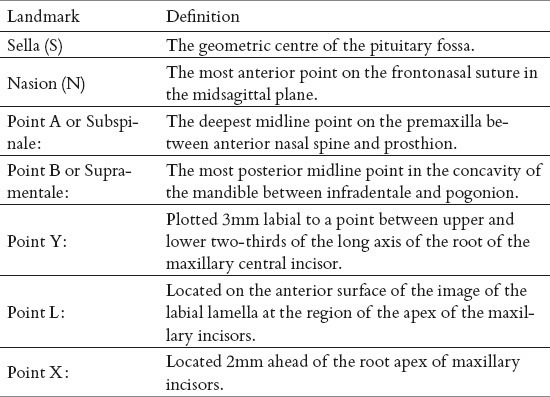
Figure 1.
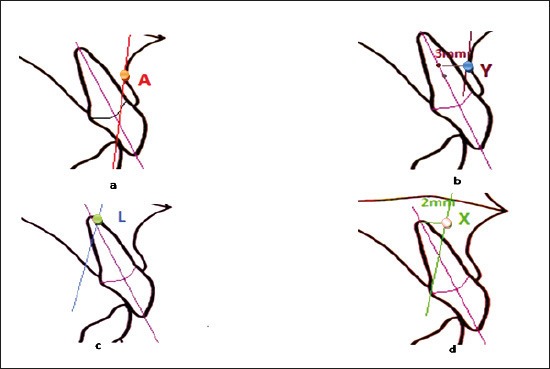
Various substitutions given by diff erent authors
Figure 2.
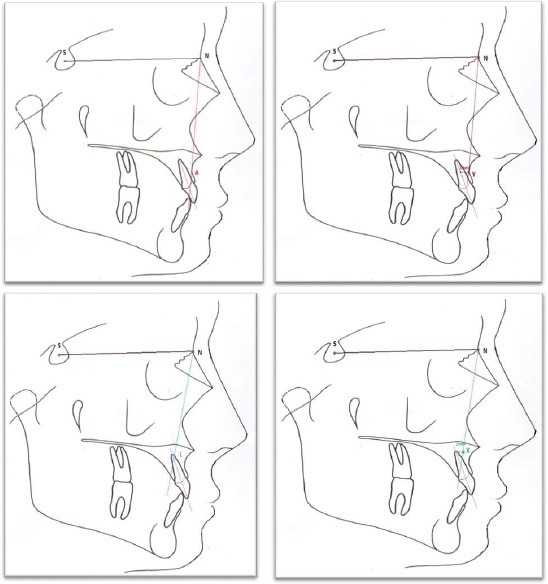
Various angles formed a: Angle SNA, b: Angle SNY, c: Angle SNL, d: Angle SNX
Satistical analysis
All the statistical tests were conducted using SPSS (version 19.0) Mean and standard deviation for Angles SNA, SNY, SNL and SNX were calculated individually for males and females. ‘T’ Test was applied to determine statistical significance for all the parameters i.e Age, Angles SNA, SNY, SNL and SNX respectively. Karl Pearson correlation coefficient was carried out to determine the statistical significant correlation for Angle SNA with SNY, SNL and SNX.
3. RESULTS
Males: A mean value of 22.1 ±4.3 years for Age was observed. A mean value of 82.80 ±1.950 for Angle SNA was observed. A mean value of 83.10 ±1.80 was observed with Angle SNY. A mean value of 78.30 ±2.90 was observed with Angle SNL. A mean value of 78.70 ±2.70 was observed with Angle SNX (Table 2).
Table 2.
Measured angles of SNA, SNY, SNL and SNX in our study
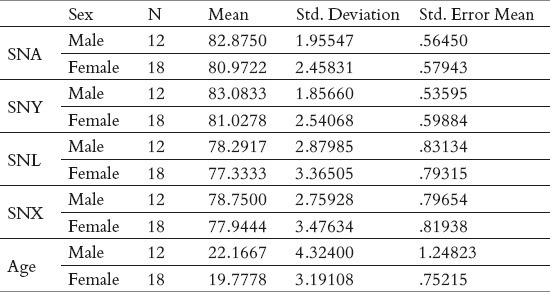
Females: A mean value of 19.8 ±3.2 years of Age was observed. A mean value of 80.90 ±2.40 was observed for Angle SNA. A mean value of 81.10 ±2.50 was observed with Angle SNY. A mean value of 77.30 ±3.40 was observed with Angle SNL. A mean value of 77.90 ±3.40 was observed with Angle SNX (Table 2). T test was carried out to determine significance amongst all the parameter Age, SNA, SNY, SNL and SNX. Angles SNA (P<0.033) and SNY (P<0.023) revealed statistical significance (Table 3).
Table 3.
Determination of statistical signifi cance for parameters SNA, SNY, SNL, SNX and Age

A correlation of age, SNA, SNY, SNL and SNX was calculated. Age had a non significant correlation with all the parameters utilized in the study. SNA revealed a strong statistically significant correlation with SNY>SNX>SNL (Table 4).
Table 4.
Determination of overall correlation coeffi cient for parameters SNA, SNY, SNL, SNX and Age
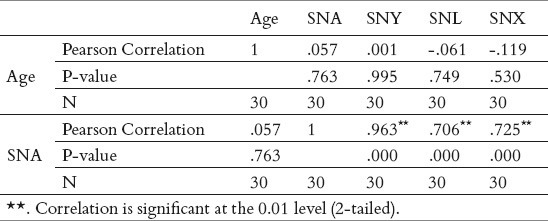
In males correlation of age, SNA, SNY, SNL and SNX was calculated. Age had a non significant correlation with all the parameters utilized in the study. Only SNA revealed a strong statistically significant correlation with SNY only. (Table 5).
Table 5.
Determination of correlation coefficient for parameters SNA, SNY, SNL, SNX and Age for females.

In females correlation of age, SNA, SNY, SNL and SNX was calculated. Age had a non significant correlation with all the parameters utilized in the study. SNA revealed a strong statistically significant correlation with SNY, SNL and SNX (Table 6).
Table 6.
Determination of correlation coefficient for parameters SNA, SNY, SNL, SNX and Age for males
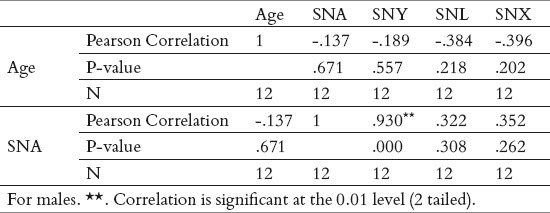
4. DISCUSSION
Apical base of maxilla and mandible help in determining the spatial relation of both maxilla and mandible to the cranial base. It also determines the limit of placement of incisors in the anteroposterior position (7). Numerous controversies exist in landmarks which are difficult to identify. Among those points, Point A is the most common point which encounters difficulty in identification. The cephalometric landmark, Point A, was investigated with regard to definition, location and usefulness in cephalometric analysis. Point A or Subspinale represents the maxillary apical base; the projection of cheeks frequently obscures this landmark in lateral cephalogram (4). Due to shortcomings of Point A various substitute landmarks have been sought by different authors by keeping the root apex of maxillary central incisor as a stable landmark. Van der Linden, suggested the use of point L, which is located on the anterior surface of the image of the labial lamella at the region of the apex of the maxillary incisors Jarabak and Fizzel identified a Point X 2mm ahead of the root apex as a redefinition of point A (1). Another Point Y plotted 3mm labial to a point between upper and lower two-thirds of the long axis of the root of the maxillary central incisor as suggested by Jacobson R. and Jacobson A (4). Comparison of mean values of Angle SNA with Angles SNY, SNL and SNX When the mean values of angles SNA, SNL, SNX and SNY were compared we observed the mean value of SNY was more in comparison to SNA, SNL and SNX. The mean values of SNL and SNX was less in comparison to SNA. Probable cause for such an observation could be attributed the variation in the definition of those cephalometric landmarks. When T test was carried out to determine significance amongst all the parameters individually like Age, SNA, SNY, SNL and SNX, Angles SNA and SNY revealed statistical significance (Table 3). This suggested that angles SNA and SNY were more specific for all the samples included in the study. On an overall SNA and SNY; SNX and SNL revealed strong statistical correlation between each other. Clear visibility of maxillary central incisor would act as a guide for marking the landmarks as require for Point Y could be attributed for such an observation. In males there was high correlation of angle SNA with angle SNY. In females, angle SNA correlated with Angle SNY, SNL and SNX, as we had observed that all the angles were less in comparison to males, which resulted in such an observation. However a further study has to be conducted on females to ascertain the probable cause for such an observation.
In almost all cases the angles SNA and SNY were equal and showed high statistical significant correlation. Abdwani et al (8) stated that the effects of incisal inclination changes, due to orthodontic treatment, are of no clinical relevance to the position of Point A and B, even though they may be statistically significant. However Kazem et al (9) reported that the position of Point A is affected by local bone remodeling associated with proclination of the upper incisor in Class II division 2 malocclusion, but this minor change does not significantly affect the SNA angle. According to Jacobson a point closer to the center of the root of a tooth is less vulnerable to displacement than, say, a point close to the root apex during crown tipping procedures. Point Y represents closer to center of the tooth root hence point Y can be used more precisely as a substitute for point A. Whereas Point L and Point X are located in relation to the root apex, which can change if the tooth is proclined or retroclined.
5. CONCLUSION
The situation of Point A is rather complex, and its location depend on a number of variables. Thus from the present study the following conclusions can be drawn: Age had no significance on identification of maxillary apical base; Overall Point; A showed strong statistically significant correlation with Point Y.; In males Point A and Point Y showed strong statistically significant correlation.; In females, Point A showed statistical significant correlation with Point Y, L and X.
Footnotes
CONFLICT OF INTEREST: NONE DECLARED.
REFERENCES
- 1.der Linden V. A study of roentgenographic bony landmarks. Am J Orthod. 1971;59:111–125. doi: 10.1016/0002-9416(71)90044-3. [DOI] [PubMed] [Google Scholar]
- 2.Baumrind S, Frantz RC. The reliability of head film measurements. 1. Landmark identification. Am J Orthod. 1971;60:111. doi: 10.1016/0002-9416(71)90028-5. [DOI] [PubMed] [Google Scholar]
- 3.Fizzel JR. St Louis: CV Mosby Co; 1963. Technique and Treatment with the Light wire appliance; p. 146. [Google Scholar]
- 4.Rick L. Jacobson and Alex Jacobson, Point A revisited. Am J Orthod. 1980;77(1) doi: 10.1016/0002-9416(80)90227-4. [DOI] [PubMed] [Google Scholar]
- 5.Jacobson A. Second Edition. Quintessence publishing; 2006. Radiographic cephalometry. [Google Scholar]
- 6.Downs WB. Variations in facial relationship. Their significance in treatment and prognosis. Am J Orthod. 1948;34:812–840. doi: 10.1016/0002-9416(48)90015-3. [DOI] [PubMed] [Google Scholar]
- 7.Kalafa JA, Kronman JH. A Critical Evaluation of Cephalometric “A” Point and Proposal of a More Significant Landmark. The Angle Orthodontist. 1968;38(3):225–230. doi: 10.1043/0003-3219(1968)038<0225:ACEOCA>2.0.CO;2. [DOI] [PubMed] [Google Scholar]
- 8.Al-Abdwani R, et al. Change of Incisor Inclination Effects on Points A and B. Angle Orthod. 2009;79:462–467. doi: 10.2319/041708-218.1. [DOI] [PubMed] [Google Scholar]
- 9.Kazem S, Al-Nimri, et al. Maxillary Incisor Proclination Effect on the Position of Point A in Class II division 2 Malocclusion. Angle Orthod. 2009;79:880–884. doi: 10.2319/082408-447.1. [DOI] [PubMed] [Google Scholar]


